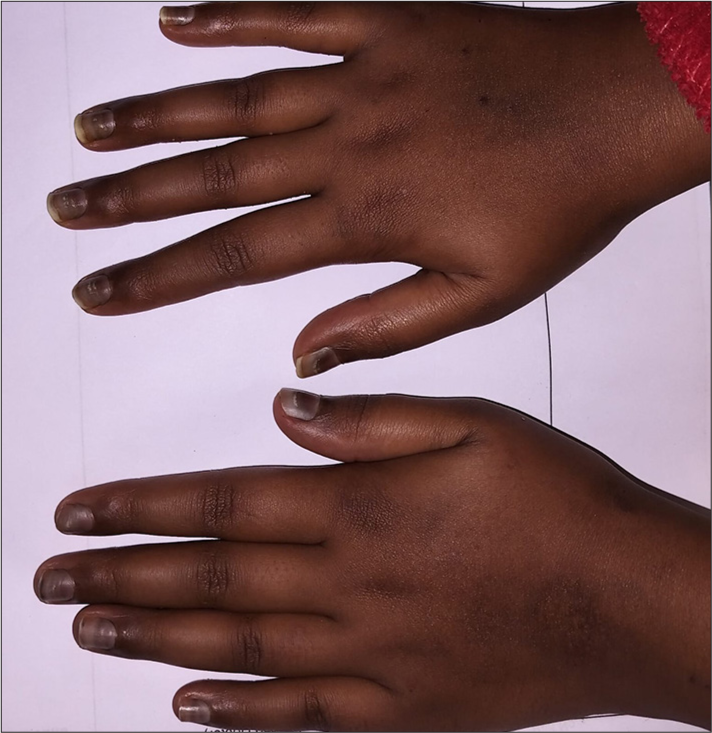Translate this page into:
Chemotherapeutics nailing it!
*Corresponding author: Pratibha Singh, Department of Haematology, Nil Ratan Sircar Medical College and Hospital, Kolkata, West Benagl, India. drpratibhasingh21@gmail.com
-
Received: ,
Accepted: ,
How to cite this article: Singh P. Chemotherapeutics nailing it! J Hematol Allied Sci. 2025;5:111-2. doi: 10.25259/JHAS_2_2025
The effects of chemotherapy agents on rapidly proliferating organs such as hair, skin, nails, and gastrointestinal tract are both associated with systemic as well as cutaneous changes. The common findings are alopecia, mucositis, dermatitis, and nail changes. Here, we will reflect on some typical nail changes in a patient undergoing chemotherapy and the various chemotherapeutic agents implicated for the same.
A 14-year-old girl, diagnosed with B – acute lymphoblastic leukemia, with multiple relapses, recently received Hyper CVAD – regimen, consisting of cyclophosphamide, vincristine sulfate, doxorubicin, dexamethasone in Phase A, and methotrexate along with cytarabine in Phase B 2 months back. She presented with pigmentary changes over the nail plate, along with transverse white lines running across the plate at equal intervals. The proximal end at the lunula maintained its normal hue.
Cytotoxic chemotherapy agents can induce a temporary arrest of the proliferative functions of the nail matrix which can present as multiple Mees’ lines in the nail plate. They appear as one or multiple transverse white bands, affecting nails at the same level and moving in the direction of nail growth distally [Figure 1]. The proliferative potential of the finger nails and toe nails is different; therefore, similar changes were not seen in the toe nails. Our patient also had melanonychia [Figure 1], dark pigmentation of nails observed as transverse bands. This usually occurs due to melanocyte activation in the matrix epithelium. The alternating bands of normal and hyperpigmented bands often correspond to the chemotherapy cycles and intermittent administration of drugs. Mees’ lines in our patient are most relevant with administration of cyclophosphamide, vincristine, and doxorubicin, and melanonychia can be due to methotrexate in addition to cyclophosphamide and daunorubicin. It is the most reversible change, often corrects once chemotherapy is stopped. The cosmetic changes often add to the anxiety and apprehension of the patient receiving these drugs. It is important to counsel the patients regarding these asymptomatic changes and instill a state of composure.

- The nail matrix along with the nail plate showing melanonychia along white alternating transverse white ridges over the nail plate – Mees’ lines.
Ethical approval
Institutional Review Board approval is not required.
Declaration of patient consent
Patient’s consent not required as patients identity is not disclosed or compromised.
Conflicts of interest:
There are no conflicts of interest.
Use of artificial intelligence (AI)-assisted technology for manuscript preparation
The author confirm that there was no use of artificial intelligence (AI)-assisted technology for assisting in the writing or editing of the manuscript and no images were manipulated using AI.
Financial support and sponsorship: Nil.





